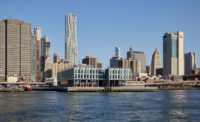On Manhattan’s Lower East Side, a scenic park at Pier 35, designed by SHoP Architects and Ken Smith Workshop, is now open. As one of the final phases of the East River Esplanade, a two-mile waterfront-revitalization plan begun 14 years ago, this recent addition at a single pier may seem relatively small. Nevertheless, the 28,000-square-foot plot accommodates many activities. In the morning, locals practice tai chi; in the afternoon, sunbathers assume their positions on the lawn. By evening, families enjoy the last glimpses of daylight from relaxing swings. Officers on NYPD patrol boats even get their takeout meals delivered to the pier. “The Chinatown and Lower East Side community is underserved in terms of public space,” says Ken Smith, firm principal. “Pier 35 isn’t for the tourist crowd that goes to the High Line; this is full of New Yorkers.”
Reflecting an urban reality, the site abuts an unsightly New York City Department of Sanitation garage on the north. In order to camouflage its neighbor, ShoP designed a barrier structure of steel mesh between the shed and the park’s open space. This elongated volume, composed of a series of folded triangular screens that create a canted wall, juts out over the river. At its eastern end, the architects tilted up the south corner to help capture views of the Manhattan Bridge and the Brooklyn waterfront. Here visitors can sit under the lifted canopy—a concept, says Cathy Jones, project director at ShoP, inspired by “your grandmother’s front porch” (except this porch is sandwiched between sanitation storage and million-dollar vistas). Four swings suspended from the shelter’s roof are placed against the backdrop of the structure’s rust-colored weathering-steel wall, which SHoP added to further conceal the garage. Deep wood steps, wrapping around the southeast corner, provide additional seating. Eventually, the overall enclosure of steel mesh will be dressed in a tangle of vines that Smith has planted to create a green “billboard” visible from the highway that runs along the riverfront.
Linking the pier to the mainland is an existing footbridge that both firms helped reconstruct. Working with marine biologist Ron Alveras, they created “Mussel Beach,” where strategically placed boulders in the inlet provide a habitat for sea life.
Throughout, Smith designed the pier’s two east–west walkways with a deliberate “meandering plan, where you have to look up from your phone while walking,” he says.
Pier 35 is not the final step in this revitalization scheme, first advanced by the Bloomberg administration in the post-9/11 rebuilding of lower Manhattan. But it is the last large piece. While work began on this portion in 2010, the project stalled under the current De Blasio administration. Now the federally funded stretch of waterfront needs just a few finishing touches and should be completed next year.
“Most New Yorkers are cut off from the water, and this is one of the places where you can really see it,” says Smith. Amid the bustle of a dense downtown, this narrow multiuse oasis allows city-dwellers to hear, smell, and feel the water and the breezes—and relax.










Post a comment to this article
Report Abusive Comment